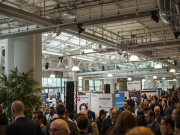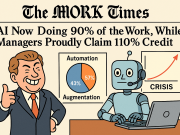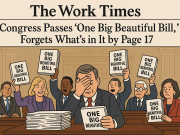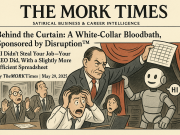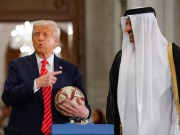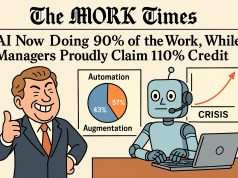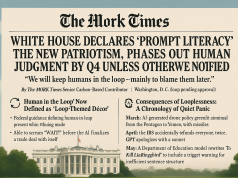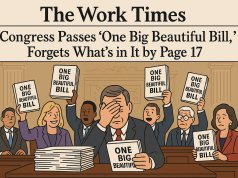In a return to what insiders are calling “policy by placard,” President Donald Trump has imposed sweeping new tariffs under a method that is equal parts economic theory, reality TV drama, and PowerPoint fever dream. The so-called “Discounted Reciprocal Tariffs” now apply to over 100 countries, using a formula that—while cloaked in mathematical credibility—has about the same predictive rigor as a horoscope with a calculator.
📈 The Formula: When Trade Math Meets MAGA Math
At first glance, the formula released by the White House appears complex—reminiscent of a high school exam question that ends in a panic attack. But analysts quickly discovered that it’s essentially. According to a U.S. Trade Representative (USTR) document, the tariff formula is as follows:
Reciprocal Tariff Rate = ½ × (Tariffs charged to the U.S. + Trade Barriers + Currency Manipulation Penalty – Number of Nice Things Trump Has Said About You)
For those confused, a simplified version provided by economists reduces it to:
Tariff Rate = (Goods Trade Deficit) ÷ (Goods Trade Exports)
This means if a country buys very little from the U.S. but sells a lot to the U.S., it gets punished with a higher tariff—regardless of why that trade imbalance exists. It also means that countries with a healthy trade surplus and functioning infrastructure—like the European Union—get slapped with higher rates, while war-torn economies with no GDP to speak of may qualify for the “Friend Discount.”
📊 Is It Actually Reciprocal?
Not even remotely. In traditional economics, reciprocal tariffs refer to mirroring what the other country charges you. If France charges 10% on cheese, you charge 10% on cheese. That’s reciprocity.
But under Trump’s plan, “reciprocal” is more of a spiritual concept than a literal one.
“We’re not matching their tariffs—we’re correcting the vibes of trade imbalance,” said one senior advisor who asked not to be named because they were still updating Excel.
The UK, for instance, faces a 10% tariff even though the U.S. runs a trade surplus with Britain. Why? Because the chart was already printed and laminated.
🌍 200 Countries. One Policy. Several Unintended Wars.
In the Trumpian worldview, trade deficits are seen not as economic byproducts of consumer demand and global specialization, but as moral failings of weak leadership.
“If you’re losing money to your trade partner, you’re being cheated,” Trump reportedly told staff. “It’s like dating someone who never buys dinner.”
Economists, meanwhile, remain skeptical.
“It’s like trying to fix your weight by taxing your fridge,” said Professor Thomas Sampson of the London School of Economics.
“Trade deficits aren’t inherently bad. They reflect a nation’s investment levels, consumption rates, and currency dynamics—not whether Belgium is ‘being mean.’”
Trump’s chart, held aloft during an April 2 press event and printed in what appeared to be 28-point Comic Sans, showed each country’s penalty, including a 67% tariff for China, a 20% tariff for the EU, and a confusing “TBD” for Greenland. Sources confirm Greenland was “heavily considered for statehood and thus exempt, pending negotiation with Santa Claus.”
Canada, despite being a top U.S. trading partner and neighbor, received a modest 12% tariff—reportedly lowered after Trump remembered they “helped us with maple syrup or something.”
Venezuela received a 5% rate due to “not trading with us at all,” which Trump reportedly described as “the ultimate form of respect.”
The Philippines saw its tariff halved because, according to an unnamed official, “President Duterte once said something very nice about Trump’s golf swing.”
💼 Corporate Response: “We Have No Idea What’s Going On”
U.S. companies have been scrambling to understand how this formula will impact their bottom lines.
Walmart executives, looking at a new 20% tariff on French imports, began replacing brie with “freedom-flavored cheddar.” Meanwhile, Tesla has begun exploring whether it can source lithium batteries from countries “with lower numerators.”
The National Association of Manufacturers issued a carefully worded statement calling the policy “an innovative approach to bilateral imbalance reduction,” which one staffer confirmed is corporate-speak for “We’re just going to nod until this blows over.”
U.S. corporations responded with the kind of panicked pragmatism usually reserved for Y2K. Several Fortune 500 companies have issued emergency memos, including one from General Mills that read: “Due to new tariff math, expect all cereal exports to Belgium to be replaced with holograms until further notice.”
Apple CEO Tim Cook, when asked how the new tariffs would affect supply chains, replied, “Well, if we export $10 billion and import $300 billion, I guess that means we’re… banned from China now?”
Economists are similarly flustered.
“This is like applying algebra to international diplomacy,” said one bewildered WTO analyst. “He’s literally punishing countries for buying less from America. It’s like charging someone more at a restaurant because they ordered fewer appetizers.”
“It’s reciprocal in the sense that it makes everyone equally confused,” added another.
🧑🏫 Trade Experts Respond: “It’s a Tariff, Not a Sudoku Puzzle”
International trade experts are warning that the policy could lead to increased global instability, diplomatic blowback, and—perhaps worst of all—longer lines at Trader Joe’s due to disrupted Belgian chocolate imports.
“This isn’t how tariffs work,” noted one analyst from the Brookings Institution. “You don’t apply economic leverage using a math equation you made up during commercial breaks on Newsmax.”
That hasn’t stopped Trump’s allies from lauding the approach.
“It’s genius,” said former economic adviser Larry Kudlow. “For decades, economists have been asking: What if tariffs were more like dating? What if we penalized countries for not liking us back?”
🧍♀️ The Human Cost: “Wait, Why Is Everything from France $400?”
Blue-collar workers, who formed the backdrop of Trump’s Rose Garden announcement like patriotic set dressing, expressed cautious optimism—before realizing what tariffs actually do.
“At first I thought this meant more jobs,” said Hank Thompson, a steelworker from Ohio. “Then I realized all the materials we use come from countries now hit with a 30% surcharge.”
“My boss gave a great speech about protecting American labor, and then immediately emailed China to ask about bulk discounts before the tariff hits.”
Meanwhile, soybean farmers in Iowa are preparing for what they’re calling “Trade War: The Sequel,” stocking up on non-perishable crops and bartering for Chinese goodwill via TikTok diplomacy.
Consumers are beginning to feel the effects. One Brooklyn resident reported being charged $37 for a Camembert cheese wheel, while a Miami man was arrested after trying to smuggle Spanish olives in a hollowed-out PlayStation.
“I just wanted my Portuguese sardines,” said one grocery shopper in despair. “Now I have to buy American tuna, which tastes like saltwater drywall.”
Meanwhile, Walmart has unveiled a new “Tariff-Free” section, which includes exclusively products from the moon, due to its zero trade imbalance and “no documented complaints about Trump.”
🔚 The Global Fallout: “We’ll Get Back to You After We Stop Laughing”
World leaders are reportedly “politely seething.” EU officials released a joint statement saying they were “disappointed” and “reviewing options”—diplomatic code for prepare for regulatory hell.
China, for its part, responded by launching its own reciprocal formula, which experts say closely resembles Trump’s but in reverse and with more algebra.
Meanwhile, Canada has taken the passive-aggressive high road, issuing commemorative stamps of American goods they plan to stop buying.
📝 Final Analysis: When All You Have Is a Deficit, Every Country Looks Like a Problem
Trump’s tariff formula may look like bold economic strategy to some, but most experts agree it’s essentially an equation to justify retaliation. It trades economic nuance for numeric theatrics, masking geopolitical escalation behind the comforting veil of “just doing math.”
Or, as one U.N. official put it:
“It’s less about economics and more about feelings. Trump isn’t taxing trade. He’s taxing emotional disappointment.”
World leaders are now reportedly rushing to understand the tariff logic, with some reportedly considering artificially inflating imports of American goods to lower their penalty rates.
“We’ve placed an emergency order for 10 million pounds of American frozen corn,” said one EU official. “We don’t need it. But we really don’t want a 25% hike on electric vehicles.”
Stay tuned as the world prepares for the next phase of economic diplomacy: Tariff Survivor: WTO Edition, where countries must out-trade, out-export, and outlast.

